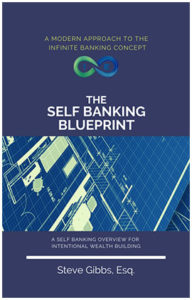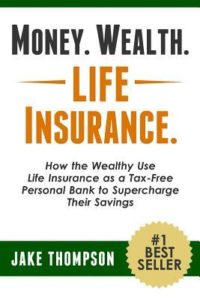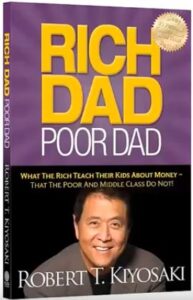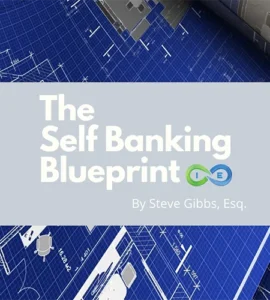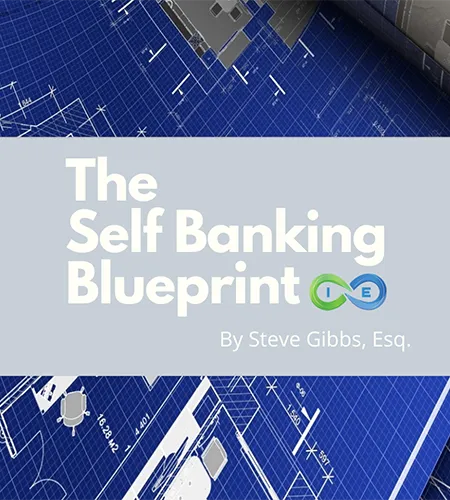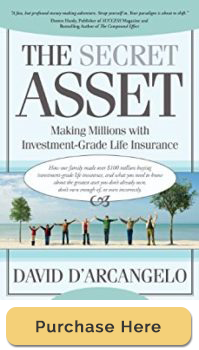
The Secret Asset: Overall Impressions
The Secret Asset by David D’Arcangelo is a mixture of really good, mixed with some things that make you scratch your head. The content and strategies presented in this book are phenomenal and literally something I’ve never seen in print. His strategies for using whole life insurance are almost counter-intuitive to some degree.
The math in The Secret Asset doesn’t lie, and that is the big eye opener. Read this book for the strategies and you’ll be pleasantly surprised. David provides a great roadmap for how a family might use his techniques to significantly increase their wealth and provide a lasting legacy for generations.
Now the head scratching part.
This book is written in a style that is extremely difficult to swallow. The book is presented as a story of a multi-generational family that wants to retire and leave a legacy for their future heirs. Every chapter following the Introduction is written as a story.
So concepts and ideas that should take 2 or 3 pages to present, require 6-7 pages of needless narrative. I don’t care what restaurant serves the best manicotti and what the expression was on the grandfather’s face. Just the facts please.
My subjective opinion is David should have stuck to the unique strategies he uses, and saved the fictional narrative for his bedtime stories.
Also note that his examples (some are quoted below) are all very high dollar figures. He states that the principles themselves work the same no matter what figures you use. I think he used the high figures because people like seeing high dollar returns and death benefits. I understand his point, but to the skeptic (and many reading his book will be skeptics) the high numbers present a potential obstacle.
Good thing you found my review as I hope to highlight the awesome concepts without all the fluff.
The Secret Asset Strategy
Simply put, The Secret Asset strategy is buying whole life insurance as an asset for those that are 70 years or older to realize the significant death benefit in a relatively short time frame.
Most modern day “financial gurus” ridicule cash value life insurance as an investment for a variety of reasons, one of which being that it is extremely expensive to buy in old age. David looks at the math and shows that Whole Life can be purchased at a very old age (70-80, or older) and the returns can be ridiculously good – when the death benefit is realized. The fact that the death benefit from life insurance is income tax free, is also very compelling.
David uses the term investment-grade life insurance to refer to the type of Whole Life insurance that he is recommending throughout the book. This type of insurance is “a portfolio asset, just like stocks, bonds, and real estate.< It can be bought at a net-zero cost, minimum-funded, over-funded, gifted, financed, 1035 exchanged, collateralized, generation skipped, and held until death, when the heirs can collect the insurance benefit without sky-high income and estate taxes.”
Investment-grade is the type of life insurance that is optimized for death benefit performance, in contrast to high cash value life insurance. It needs to be designed and purchased correctly in order to provide the opportunities presented in this book. David recommends seeking help in this area after doing your research.
David also talks about the return on investment (ROI) for investment-grade life insurance purchased by the young. But this is not the main focus of the book, and seems to be more of a late addition to supplement the main strategy.
A Practical Example
To give you an idea of what David is suggesting, let’s look at the example he provides in his second chapter, titled
“Why Smart People Make More Money.”
“Remember, we already knew Grandpa John’s average life expectancy when he purchased his policy was 14.22 years (age 83.22) and not forty years (age 109).
My recommendation was to dollar cost average $94,839 annually out of his investment portfolio that was earning 1 percent in short-term treasuries, 5 percent in bonds, and -20 percent to +20 percent in the stock market into a life insurance contract to control a potential $4 million life insurance benefit.
The performance of this policy is correlated to his life expectancy and…Grandpa John [can] monitor … his health while diversifying his investment portfolio $94,839 per year on a product that pays a tax-free $4 million to his wife upon his death.”
In this example David suggests that an individual male (Grandpa John) can purchase a $4 million policy at age 69 for $93,839 premium per year. The premium is very high, and this is where most “guru’s” cry and moan about the cost being ridiculous. But pay attention. Let’s look at the math by evaluating the return.
“If Grandpa John had passed away at age eighty-three, the original life expectancy at the time of purchase, the internal rate of return would have been 13.81 percent tax free. The tax equivalent return you would have to earn to net 13.81 percent is 21.25 percent in the 35 percent tax bracket. Think about that. What other investment/business do you have compounding year in and year out at 21.25 percent pretax annually? Real estate? No way.”
Clearly the return on investment was incredibly good in this example. But he also addresses the obvious question –
“What if Grandpa lives longer?”
“Even if Grandpa John had lived five years past the average life expectancy, to age eighty-eight, the return would have still been an impressive 7.47 percent (or you would have to earn the taxable equivalent, 11.50 percent in the 35 percent tax bracket).”
Now it’s true that Grandpa John could live to 90 or 95, and David doesn’t address that, but it’s important to note that the payout is guaranteed as long as premiums are paid. So the $4 million tax-free benefit is a guarantee. And you can always cash out prior to death by selling your policy for a profit (life settlement).
“But what if Grandpa dies sooner than expected?”
“So, when Grandpa John died at age seventy-nine, the IRR return was a whopping 25.25 percent tax free. The tax-free equivalent yield you would have to earn to net 25.25 percent would be 35.35 percent in the 35 percent federal tax bracket!”
The Secret Asset presents a Grandpa that pays $938k in premiums over the course of 10 years, and then dies to provide a $4 million tax-free death benefit to his heirs.
As I mentioned earlier, the skeptic sees these numbers and may be tempted to dismiss them. But according to David D’Arcangelo, if you reduce the premiums by a factor of 10, the principle he is advocating in the Secret Asset still applies. A $400,000 tax-free death benefit can be awarded with an annual premium of $9,300 or so. That is much more affordable and easily within reach for many working Americans.
How can Premiums be this Affordable?
The natural question to ask after seeing the example above is “How can premiums be that low?” Surely the insurance companies would go out of business if they had to pay out all these death benefits after receiving such a small sum in premiums.
Insurance is all about pooling the risk and spreading out the cost. Only 1 out of every 8 people that own this type of permanent life insurance go the distance and get the death benefit. So the payout is essentially subsidized by those that leave early.
To be honest, you can thank the financial “gurus” for convincing people that their whole life policies should be cancelled in favor of cheap term life insurance. Every time they convince a whole life policy owner to “buy term and invest the rest” they ensure that the premiums stay more affordable for those that go the distance.
David stresses that those that have the will (i.e. discipline) to go the distance are the ones that end up beating the system and coming out ahead of the game. He later goes on to show how death benefit payouts can then fund larger policies, with one time premiums, creating a legacy that grows with each generation.
Wrap-up
The book goes on to mention other elements of investment-grade life insurance that readers will likely find useful.
The 2-for-1 strategy he presents is all about utilizing second-to-die survivorship life insurance to lower the overall cost of premiums for couples looking to leave a legacy gift to their children.
In addition he talks about the “what if” scenario of a family emergency requiring a cash out of the policy. David also presents what he considers to be the “perfect investment” in a more theoretical discussion.
And finally, he showcases what it might look like for a young individual to overfund a policy for 20 years early on in their life through the use of limited pay life insurance.
The overfunding scenario he presents is exactly what we talk about in our Infinite Banking Wiki, so as a concept it’s nothing new.
But as I mentioned earlier in this review, David D’Arcangelo packs The Secret Asset with something I have yet to see in printed form. He provides the reader with a compelling reason to buy permanent life insurance for the elderly. For that reason alone, I think this book is worth your time.
